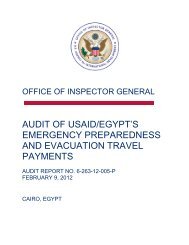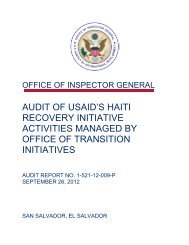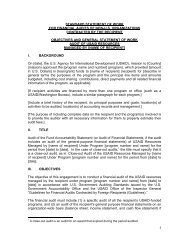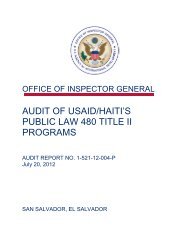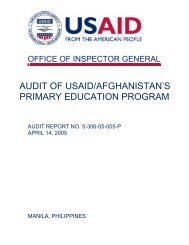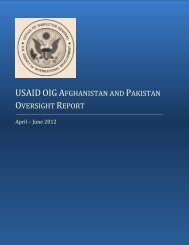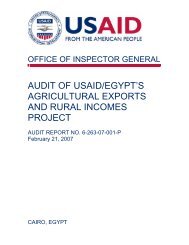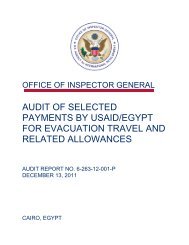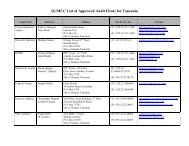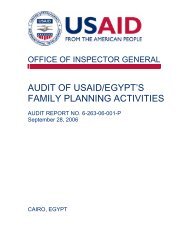Audit of USAID/AFGHANISTAN'S SCHOOL AND HEALTH CLINIC ...
Audit of USAID/AFGHANISTAN'S SCHOOL AND HEALTH CLINIC ...
Audit of USAID/AFGHANISTAN'S SCHOOL AND HEALTH CLINIC ...
You also want an ePaper? Increase the reach of your titles
YUMPU automatically turns print PDFs into web optimized ePapers that Google loves.
OFFICE OF INSPECTOR GENERALAUDIT OF <strong>USAID</strong>/AFGHANISTAN’S<strong>SCHOOL</strong> <strong>AND</strong> <strong>HEALTH</strong> <strong>CLINIC</strong>RECONSTRUCTION ACTIVITIESAUDIT REPORT NO. 5-306-06-008-PAugust 18, 2006MANILA, PHILIPPINES
Office <strong>of</strong> Inspector GeneralAugust 18, 2006MEMOR<strong>AND</strong>UMTO:FROM:SUBJECT:<strong>USAID</strong>/Afghanistan Director, Leon S. WaskinRegional Inspector General/Manila, Catherine M. Trujillo /s/<strong>Audit</strong> <strong>of</strong> <strong>USAID</strong>/Afghanistan’s School and Health Clinic Reconstruction Activities(<strong>Audit</strong> Report No. 5-306-06-008-P)This memorandum transmits our final report on the subject audit. In finalizing the report, weconsidered your comments to the draft report and included the comments (without attachments)in Appendix II.This report contains two recommendations to improve <strong>USAID</strong>/Afghanistan’s school and healthclinic reconstruction activities. Based on your comments, we consider that a managementdecision has been reached on Recommendation No. 1. Please provide the <strong>Audit</strong>, Performanceand Compliance Division <strong>of</strong> <strong>USAID</strong>’s Office <strong>of</strong> the Chief Financial Officer with evidence <strong>of</strong> finalaction in order to close this recommendation. Regarding Recommendation No. 2, we considerthat final action has been taken on the recommendation.I want to thank you and your staff for the cooperation and courtesy extended to us during theaudit.U.S. Agency for International DevelopmentPNB Financial Center, 8 th FloorRoxas Blvd., 1308 Pasay CityManila, Philippineswww.usaid.gov
CONTENTSSummary <strong>of</strong> Results ....................................................................................................... 1Background ..................................................................................................................... 2<strong>Audit</strong> Objective.................................................................................................................. 3<strong>Audit</strong> Findings................................................................................................................. 4Were <strong>USAID</strong>/Afghanistan’s school and health clinicreconstruction activities on schedule to achieve plannedoutputs?Reconstruction Issues Need Resolution .................................................................... 7Evaluation <strong>of</strong> Management Comments ......................................................................... 8Appendix I – Scope and Methodology .......................................................................... 9Appendix II – Management Comments ....................................................................... 11
SUMMARY OF RESULTSThe Regional Inspector General/Manila conducted this audit to determine whether<strong>USAID</strong>/Afghanistan’s school and health clinic reconstruction activities were on scheduleto achieve planned outputs. (See page 3.)<strong>USAID</strong>/Afghanistan’s school and health clinic reconstruction activities were on scheduleto achieve planned outputs. Specifically, at April 19, 2006, <strong>USAID</strong>/Afghanistan and itsimplementing partners were on schedule to complete 705 (91 percent) <strong>of</strong> the 776 schooland health clinic buildings planned to be constructed or refurbished under the Schoolsand Clinics Construction and Refurbishment Program (SACCARP). Further, 511 <strong>of</strong> the705 buildings had already been completed and turned over to the Government <strong>of</strong>Afghanistan. (See page 4.)Although it was on schedule to achieve 91 percent <strong>of</strong> its planned outputs, it has taken<strong>USAID</strong>/Afghanistan much longer than anticipated to reach this point. Factors such asdeteriorating security and weather restrictions, which were beyond the Mission’s control,were <strong>of</strong>ten responsible for the roll back <strong>of</strong> completion dates and changes to the number<strong>of</strong> buildings to be reconstructed under the SACCARP. (See pages 5-6.) Although somefactors were beyond its control, the Mission contributed to delays in getting 71 buildingscompleted. (See page 7.)This report made two recommendations to improve <strong>USAID</strong>/Afghanistan’s school andhealth clinic reconstruction activities. (See page 7.) In response to our draft report,<strong>USAID</strong>/Afghanistan concurred with the audit recommendations. Based on ourevaluation <strong>of</strong> the Mission’s comments and supporting documentation, we consider that amanagement decision has been reached on Recommendation No. 1 and final action hasbeen taken on Recommendation No. 2. (See page 8.) <strong>USAID</strong>/Afghanistan’s commentsare included as Appendix II to this report. (See page 11.)1
BACKGROUND<strong>USAID</strong>/Afghanistan’s school and health clinic reconstruction activities, now referred to asthe Schools and Clinics Construction and Refurbishment Program (SACCARP), havehad a history <strong>of</strong> changes to the number <strong>of</strong> schools and health clinics to be reconstructedand extensions to the dates by which the reconstruction was to have been completed.In September 2002, under its Rehabilitation <strong>of</strong> Economic Facilities and ServicesProgram, <strong>USAID</strong>/Afghanistan began to reconstruct schools and health clinics throughoutAfghanistan. Initially, <strong>USAID</strong>/Afghanistan tasked The Louis Berger Group, Inc. (LBGI) tocomplete up to 40, 140, and 240 school and health clinic buildings cumulatively incalendar years 2003, 2004, and 2005, respectively.In March 2004, <strong>USAID</strong>/Afghanistan removed all but 105 buildings from LBGI’s contractbecause it was not satisfied with the contractor’s progress on the school and health clinicbuildings that it had begun to reconstruct in 2003.In May 2004, <strong>USAID</strong>/Afghanistan entered into cooperative agreements with fiveinternational nongovernmental organizations, which along with LBGI were to reconstructa total <strong>of</strong> 779 school and health clinic buildings. The Mission also found it necessary torevise its building-completion target date from June 2004 to September 2004.In October 2004, the OIG audited the school and health clinic reconstruction activities.At that time, <strong>USAID</strong>/Afghanistan had planned to complete 533 buildings byDecember 31, 2004. Our audit reported that the Mission would complete only 328buildings by December 31, 2004. In response to our audit recommendation,<strong>USAID</strong>/Afghanistan developed a new implementation plan, which set August 31, 2005,as the new target date to complete the 533 buildings.In January 2006, <strong>USAID</strong>/Afghanistan confirmed to the OIG that it had not met theAugust 31, 2005, target date and that school and health clinic reconstruction activitieswere still ongoing. Consequently, the OIG decided to conduct a second audit <strong>of</strong> theseactivities.Table 1 on page 4 shows that by the time our second audit began in April 2006,<strong>USAID</strong>/Afghanistan had increased the number <strong>of</strong> schools and health clinics it planned toreconstruct from 533 to 776 and the number <strong>of</strong> implementing partners from six to seven.Furthermore, the Mission did not plan to complete all 776 buildings untilSeptember 29, 2006.At <strong>USAID</strong>/Afghanistan, the Office <strong>of</strong> Infrastructure, Engineering and Energy isresponsible for overseeing the SACCARP. From September 2002 through April 2006,the Mission’s total obligations and disbursements for the SACCARP were approximately$92 million and $81 million, respectively.2
AUDIT OBJECTIVEThe Regional Inspector General/Manila added this audit to its fiscal year 2006 audit planto answer the following question:• Were <strong>USAID</strong>/Afghanistan’s school and health clinic reconstruction activities onschedule to achieve planned outputs?Appendix I contains a discussion <strong>of</strong> the audit’s scope and methodology.3
AUDIT FINDINGS<strong>USAID</strong>/Afghanistan’s school and health clinic reconstruction activities were on scheduleto achieve planned outputs.As Table 1 illustrates, at April 19, 2006, <strong>USAID</strong>/Afghanistan and its implementing partnerswere on schedule to complete 705 (91 percent) <strong>of</strong> the 776 school and health clinic buildingsplanned to be constructed or refurbished under the Schools and Clinics Construction andRefurbishment Program (SACCARP). Further, 511 <strong>of</strong> the 705 buildings had already beencompleted and turned over to the Government <strong>of</strong> Afghanistan. 1 The completed buildingsconsisted <strong>of</strong> 314 schools (90 newly constructed and 224 refurbished) and 197 health clinics(140 newly constructed and 57 refurbished).Table 1: School and Health Clinic Reconstruction Progress(As <strong>of</strong> April 19, 2006)Implementing AwardPlannedNumber <strong>of</strong>Number <strong>of</strong>CompletedNumber <strong>of</strong>IncompleteOnSchedulePartner End Date Buildings Buildings Buildings Yes NoCooperativeHousingFoundationInternational 11/30/2005 60 9 51 9 51InternationalOrganization forMigration 12/15/2006 2 454 299 155 454 0The LouisBerger Group,Inc. 03/31/2006 105 90 15 90 15Shelter for Life 03/30/2006 52 49 3 49 3UnitedMethodistCommittee onRelief 02/28/2006 26 24 2 24 2United NationsOffice forProjectServices 06/30/2006 70 40 30 70 0U.S. ArmyCorps <strong>of</strong>Engineers 09/29/2006 9 0 9 9 0Totals 776 511 265 705 711 We classified a school or health clinic building as “completed” if it met <strong>USAID</strong>/Afghanistan’sdefinition <strong>of</strong> “substantially completed”, which was a building that could be safely and effectively usedby the public without further delays, disruption, or other impediments.2 We used this date because, at the time <strong>of</strong> our fieldwork, <strong>USAID</strong>/Afghanistan had approved anaction memorandum to modify International Organization for Migration’s agreement, whichincluded extending the agreement from May 31, 2006, to December 15, 2006.4
OIG photograph <strong>of</strong> a school ready forinspection in Parwan, Afghanistan. (May 2006)OIG photograph <strong>of</strong> a clinic that providesbasic health care services to 35-40 patientsper day in Paktya, Afghanistan. (May 2006)At April 19, 2006, a total <strong>of</strong> 265 buildings were in various stages <strong>of</strong> completion. Seventyone <strong>of</strong> these buildings were not completed by the respective agreement or contract enddate. On May 4, 2006, the Acting Mission Director signed an action memorandum totransfer most <strong>of</strong> the 71 buildings to the International Organization for Migration (IOM) and toextend IOM’s agreement to December 15, 2006, to allow time for their completion. By theend <strong>of</strong> our fieldwork, the Mission had not modified IOM’s agreement to reflect the transfer(see discussion at page 7).Although it was on schedule to achieve 91 percent <strong>of</strong> the SACCARP’s planned outputs, ithas taken <strong>USAID</strong>/Afghanistan much longer than anticipated to reach this point. Forexample, although 511 buildings had been completed by April 19, 2006, the total is still lessthan the 533 buildings the Mission had previously planned to complete byDecember 31, 2004. As noted in the “Background” section <strong>of</strong> this report, the Mission, on anumber <strong>of</strong> occasions, rolled back the dates by which it expected to complete reconstructionunder the SACCARP. For example, the award end dates for five implementing partnerswere extended an average <strong>of</strong> three times since May 2004. Even with extensions, fourimplementing partners were not able to complete the 71 buildings discussed in thepreceding paragraph—buildings originally scheduled to be completed byDecember 31, 2004.Factors beyond <strong>USAID</strong>/Afghanistan’s control were <strong>of</strong>ten responsible for the roll back <strong>of</strong>completion dates and changes to the number <strong>of</strong> buildings to be reconstructed under theSACCARP. 3 These factors included:• Deteriorating security. Since May 2004, 11 <strong>USAID</strong>-funded schools and health clinicshave been damaged or destroyed by terrorist attacks. Seven <strong>of</strong> the 11 have been hitsince the beginning <strong>of</strong> 2006, representing a recent upsurge <strong>of</strong> such attacks.3 Some <strong>of</strong> these constraints have been reported on by the OIG and the General AccountabilityOffice (GAO): OIG Report No. 5-306-05-003-P, dated March 14, 2005, “<strong>Audit</strong> <strong>of</strong><strong>USAID</strong>/Afghanistan’s School and Clinic Reconstruction Program”; and GAO-05-742, dated July28, 2005, “Afghanistan Reconstruction: Despite Some Progress, Deteriorating Security andOther Obstacles Continue to Threaten Achievement <strong>of</strong> U.S. Goals”.5
• Poor subcontractor performance, compounded by the lack <strong>of</strong> skilled labor.Implementing partners have terminated a combined total <strong>of</strong> 31 subcontractors for poorperformance, mismanagement, or other contract breaches.• Questionable site selection. Afghan ministries, in some cases, selected hard-to-accesssites for a school or health clinic. For example, the site selected for the Argo PrimarySchool in Badakhshan province was on a mountain slope (see photographs below),which, according to a monitoring report obtained from the Mission, posed a danger tothe school’s stability during the rainy season.U.S. Army Corps <strong>of</strong> Engineersphotographs <strong>of</strong> the incompleteArgo Primary School built on theslope <strong>of</strong> a mountain inBadakhshan, Afghanistan. (May2006)• Weather restrictions. In certain areas, reconstruction has to halt during the winter.• U.S. government expectations. Since the beginning <strong>of</strong> the SACCARP, the Mission hasagreed to overly ambitious targets considering the environment in Afghanistan. Evenafter a March 2005 OIG report cited overly optimistic expectations as a problem; theMission raised its target from 533 to 776 buildings.Regarding overly optimistic expectations, a <strong>USAID</strong>/Afghanistan <strong>of</strong>ficial explained that a highgoal was set for the SACCARP because <strong>USAID</strong> and the U.S. Department <strong>of</strong> State wantedto ensure that Afghanistan “would not go back to where it was before”. One <strong>of</strong>ficial addedthat the U.S. government initially thought that it needed to help 20 million people inAfghanistan, but now the country has 28 million people. So, he concluded, there is now agreater need for schools and health clinics.Although some factors were beyond its control, we noted instances where<strong>USAID</strong>/Afghanistan should have taken more timely action to address performance issuesaffecting the SACCARP.6
Reconstruction IssuesNeed Resolution<strong>USAID</strong>’s Automated Directives System Chapter 202.3.6.3 states that, depending on thesituation, operating units may need to develop an entirely new activity and instrument, orsimply modify and change an existing activity to ensure effective use <strong>of</strong> <strong>USAID</strong> funding.<strong>USAID</strong>/Afghanistan did not take timely action to resolve issues involving 66 <strong>of</strong> the 71schools and health clinics that were not completed on schedule. For example, fromAugust 2004 to August 2005, The Louis Berger Group, Inc. repeatedly requested thatthe Mission allow it to terminate the reconstruction <strong>of</strong> 13 buildings because <strong>of</strong> precarioussecurity at the project sites. However, as <strong>of</strong> May 17, 2006, the end <strong>of</strong> our auditfieldwork, the Mission had not taken any actions on the 13 partially completed buildings.In November 2005, the Mission did not extend its agreement with Cooperative HousingFoundation International (CHF) to construct 60 buildings because <strong>of</strong> past performance. Itwas not until May 4, 2006, however, that the Mission decided to transfer the 51 buildingsthat CHF did not complete to IOM and, as <strong>of</strong> May 17, 2006, it had not modified IOM’sagreement to add the 51 buildings. Again in November 2005, when United MethodistCommittee on Relief’s (UMCOR) agreement ended, the Mission decided to transfer to IOMthe two buildings that UMCOR did not complete. But, as <strong>of</strong> May 17, 2006, the Mission hadnot modified IOM’s agreement to reflect the transfer.In May 2006, the OIG reported that <strong>USAID</strong>/Afghanistan had not taken timely action on anissue affecting the performance <strong>of</strong> another program. 4 The OIG recommended that theMission establish procedures to document, track and promptly resolve significant issuesuncovered in its own monitoring efforts that could affect the progress <strong>of</strong> its reconstructionactivities. About the time our fieldwork ended on this audit, the Mission provided evidencethat it had established such procedures, which, in the future, should help it identify and taketimely action on issues such as those discussed in the preceding paragraph. Therefore, weare not making another recommendation here on the need for such systemic procedures,but we are making two recommendations specific to the 66 schools and health clinics.By not taking timely action, <strong>USAID</strong>/Afghanistan contributed to delays in getting the 66buildings completed. To help ensure the effective use <strong>of</strong> <strong>USAID</strong> funding, we are makingthe following recommendations:Recommendation No. 1: We recommend that <strong>USAID</strong>/Afghanistan make a finaldecision on what to do with the 13 buildings that The Louis Berger Group, Inc. didnot complete and take any actions necessary to carry out its decision.Recommendation No. 2: We recommend that <strong>USAID</strong>/Afghanistan immediatelymodify the scope <strong>of</strong> work in its agreement with the International Organization forMigration to add the 51 buildings not completed by Cooperative HousingFoundation International and the two buildings not completed by the UnitedMethodist Committee on Relief.4OIG Report No. 5-306-06-005-P, “<strong>Audit</strong> <strong>of</strong> <strong>USAID</strong>/Afghanistan’s Reconstruction <strong>of</strong> theKandahar-Herat Highway Under the Rehabilitation <strong>of</strong> Economic Facilities and Services (REFS)Program”.7
EVALUATION OFMANAGEMENT COMMENTSIn its response to our draft report, <strong>USAID</strong>/Afghanistan concurred with the tworecommendations.For Recommendation No. 1, <strong>USAID</strong>/Afghanistan management concluded that securityconditions still prevented reconstruction <strong>of</strong> the 13 schools and health clinics that theLouis Berger Group, Inc. (LBGI) could not complete. Consequently, the Mission Directorsigned an action memorandum formally canceling work on the 13 buildings. However,LBGI’s contract had not yet been modified to delete the buildings. We consider that amanagement decision has been reached on this recommendation; it can receive finalaction when LBGI’s contract is modified. The Mission should coordinate final action withthe <strong>Audit</strong> Performance and Compliance Division <strong>of</strong> <strong>USAID</strong>’s Office <strong>of</strong> the Chief FinancialOfficer. Although it canceled work on the 13 schools and health clinics, the Missionintends to annually review their situation to determine if it can complete them.For Recommendation No. 2, <strong>USAID</strong>/Afghanistan management modified its agreementwith the International Organization for Migration to add the 51 buildings not completed byCooperative Housing Foundation International and the two buildings not completed byUnited Methodist Committee on Relief. Consequently, we consider that final action hasbeen taken on this recommendation.<strong>USAID</strong>/Afghanistan’s comments are included without attachments in Appendix II.8
APPENDIX ISCOPE <strong>AND</strong> METHODOLOGYScopeThe Regional Inspector General/Manila conducted this audit in accordance withgenerally accepted government auditing standards to determine whether<strong>USAID</strong>/Afghanistan’s school and health clinic reconstruction activities, now referred to asthe Schools and Clinics Construction and Refurbishment Program (SACCARP), were onschedule to achieve planned outputs.The audit covered SACCARP’s planned outputs as <strong>of</strong> April 19, 2006, as contained in theMaster List, the Mission’s database for the school and health clinic buildings undergoingconstruction or refurbishment. As <strong>of</strong> April 2006, the Mission had recorded obligations <strong>of</strong>about $92 million and disbursements <strong>of</strong> about $81 million for SACCARP. The auditfieldwork was conducted from April 22 to May 17, 2006, at the Kabul <strong>of</strong>fices <strong>of</strong> the Mission,the Afghan Ministries <strong>of</strong> Education and Public Health, and five implementing partners. Thefieldwork included visits to ten project sites in the Badakhshan, Ghazni, Kabul, Logar,Paktya, and Parwan provinces <strong>of</strong> Afghanistan.In planning and performing the audit, we reviewed and assessed the significant internalcontrols used by <strong>USAID</strong>/Afghanistan to ensure that SACCARP activities were on scheduleto achieve planned outputs. The assessment included controls related to whether theMission (1) conducted and documented site visits to evaluate progress and monitor quality;(2) reviewed progress and monitoring reports submitted by the implementing partners; (3)maintained a reliable tracking list or database on the progress <strong>of</strong> each project site; and (4)established and maintained a separate project file for each project site. We also reviewedthe Mission’s Federal Managers’ Financial Integrity Act report for fiscal year 2005 for anyissues related to the audit objective. Finally, we reviewed relevant prior audit reports.The planned outputs under SACCARP were the reconstruction <strong>of</strong> 776 schools and healthclinics. <strong>USAID</strong>/Afghanistan maintained a master list <strong>of</strong> the 776 project sites. From thismaster list, we judgmentally selected 616 project sites to test whether the master listaccurately and completely reported the reconstruction status <strong>of</strong> each school and healthclinic.MethodologyTo answer the audit objective, we interviewed <strong>of</strong>ficials and staff from <strong>USAID</strong>/Afghanistan,the two host government ministries, and five <strong>of</strong> the seven implementing partners. We didnot interview <strong>of</strong>ficials at Cooperative Housing Foundation International because it closed its<strong>of</strong>fices in Kabul when its agreement with the Mission expired in 2005. We also did notinterview <strong>of</strong>ficials <strong>of</strong> the U.S. Army Corps <strong>of</strong> Engineers because, at the time <strong>of</strong> our audit, ithad not started to reconstruct any schools or health clinics.In addition, we reviewed documentary evidence to test whether the project data in<strong>USAID</strong>/Afghanistan’s master list accurately and completely reported the status <strong>of</strong> the 776schools and health clinics that were to be reconstructed. The evidence included:9
APPENDIX I• Documents supporting the completion <strong>of</strong> a building, such as the substantialcompletion inspection punch list and <strong>USAID</strong> letters <strong>of</strong> award <strong>of</strong> substantialcompletion or final acceptance.• Documents supporting the in-progress status <strong>of</strong> a building, such as implementingpartners’ progress reports and <strong>USAID</strong> monitoring reports and photographs taken atproject sites.• <strong>USAID</strong>’s implementation plan.• Implementing partners’ contracts or agreements, their modifications, and relatedcorrespondence.• Laws, regulations, and <strong>USAID</strong> policy and guidance related to the audit objective.Furthermore, we reviewed project files for selected buildings maintained by theimplementing partners and, to the extent permitted by security conditions, we visitedproject sites.We answered the audit objective using the following parameters:• The audit objective would be met if 90 percent <strong>of</strong> all planned outputs were achievedor were on schedule to be achieved by their latest award end date.• The audit objective would be partly met if less than 90 percent, but not less than 70percent, <strong>of</strong> all planned outputs were achieved or were likely to be achieved by theirlatest award end date.• The audit objective would not be met if less than 70 percent <strong>of</strong> all planned outputswere achieved or were likely to be achieved by their latest award end date.10
MANAGEMENT COMMENTSAPPENDIX II<strong>USAID</strong> AFGHANISTANFROM THE AMERICAN PEOPLEMEMOR<strong>AND</strong>UMTO:FROM:SUBJECT:Catherine M. Trujillo, RIG/Manila,Leon S. Waskin, Mission Director /s/August 14, 2006<strong>USAID</strong>/Afghanistan – Response to Draft <strong>Audit</strong>Report – <strong>Audit</strong> <strong>of</strong> <strong>USAID</strong>/Afghanistan’s School andHealth Clinics Reconstruction Activities, Draft<strong>Audit</strong> Report dated July 14, 2006. (Report No. 5-306-06-00X-P)We appreciate the opportunity to respond to the subject draftreport. The Mission concurs with the draft report and hasaccordingly taken corrective action to address the recommendationsas detailed below:Recommendation No. 1. We recommend that<strong>USAID</strong>/Afghanistan make a final decision on what to dowith the 13 buildings that The Louis Berger Group, Incdid not complete and take any actions necessary tocarry out its decision.<strong>USAID</strong>/Afghanistan Response: The Mission has made a finaldecision to cancel construction <strong>of</strong> the 13 buildings thatLouis Berger Group, Inc. (LBGI) could not complete due tothe critical security situation at the sites where thesebuildings were to be located. Attached is the actionmemorandum approved by the Mission Director canceling nineschools and four clinics that were part <strong>of</strong> the 105 totalschools and clinics planned to be constructed by LBGI.U.S. Agency for International DevelopmentGreat Massoud RoadKabulAfghanistanTel: (202) 216-6288Fax: (202) 216-6288 ext. 4162http://www.usaid.gov/locations/asia_near_east/afghanistan11
APPENDIX IIRecommendation No. 2. We recommend that<strong>USAID</strong>/Afghanistan immediately modify the scope <strong>of</strong> workin its agreement with the International Organizationfor Migration to add the 51 buildings not completed byCooperative Housing Foundation International and thetwo building not completed by the United MethodistCommittee on Relief.<strong>USAID</strong>/Afghanistan Response: In response to therecommendation, the Mission has modified its agreement withInternational Organization for Migration to add 50buildings not completed by Cooperative Housing FoundationInternational and the two buildings (One School and OneClinic) not completed by United Methodist Committee onRelief. Please find attached Modification No.10 <strong>of</strong>Cooperative Agreement Number 306-A-00-04-00532-00 withInternational Organization for Migration. Please note thatthe 51 st building incorporated in the recommendation abovewas also modified in a separate modification document alsoattached.Based on the corrective actions outlined above,<strong>USAID</strong>/Afghanistan requests closure (final action) <strong>of</strong>Recommendations No. 1 and 2 upon issuance <strong>of</strong> the finalaudit report.Finally, <strong>USAID</strong>/Afghanistan and its implementing partnersare proud <strong>of</strong> achieving 91% <strong>of</strong> the planned outputs duringthis period <strong>of</strong> significant instability in Afghanistan. Webelieve this is an enviable achievement under anycircumstance, but especially in a war zone with the addedconstraints identified by the audit team in the draftreport.Thank you.Attachments: As stated.12
U.S. Agency for International DevelopmentOffice <strong>of</strong> Inspector General1300 Pennsylvania Ave, NWWashington, DC 20523Tel: (202) 712-1150Fax: (202) 216-3047www.usaid.gov/oig



